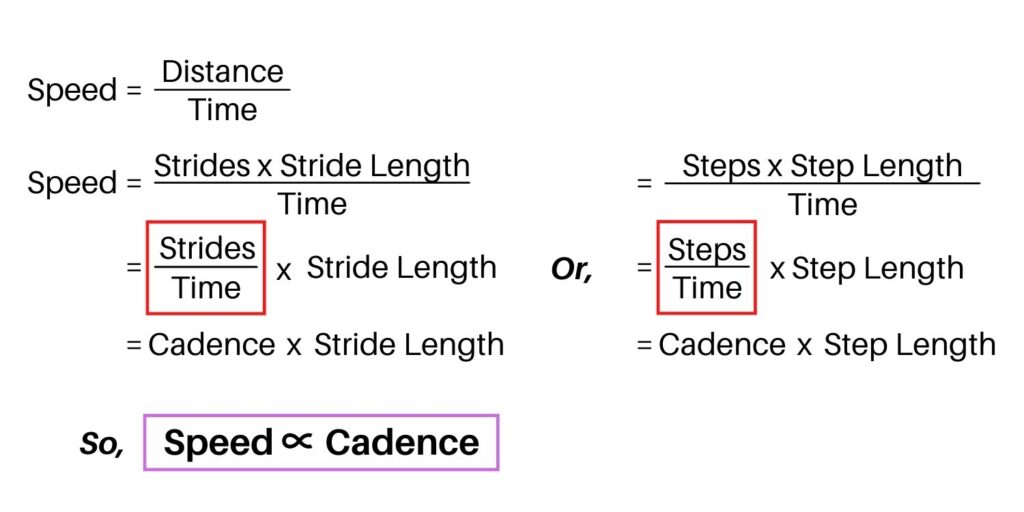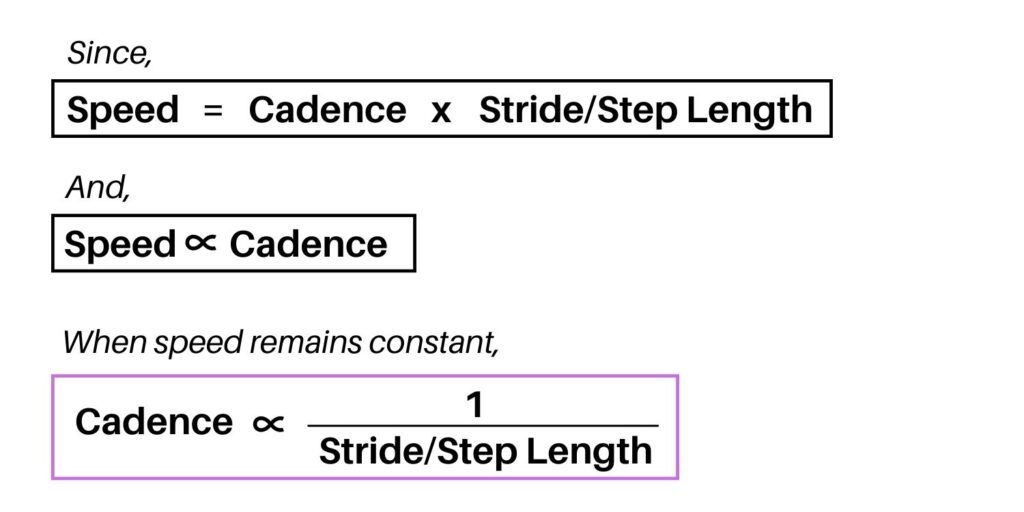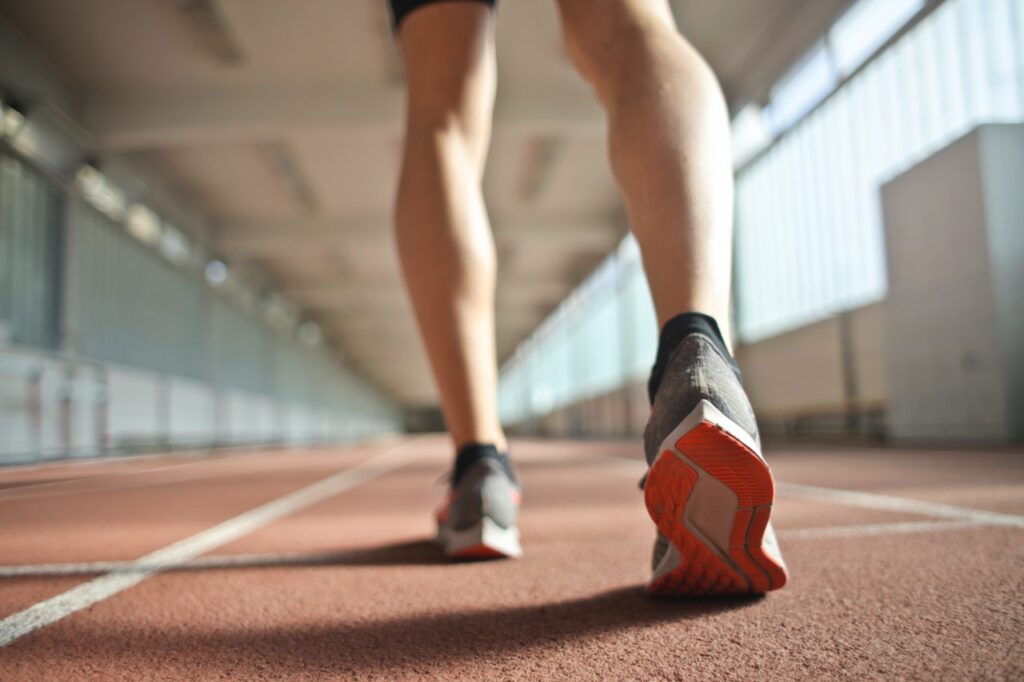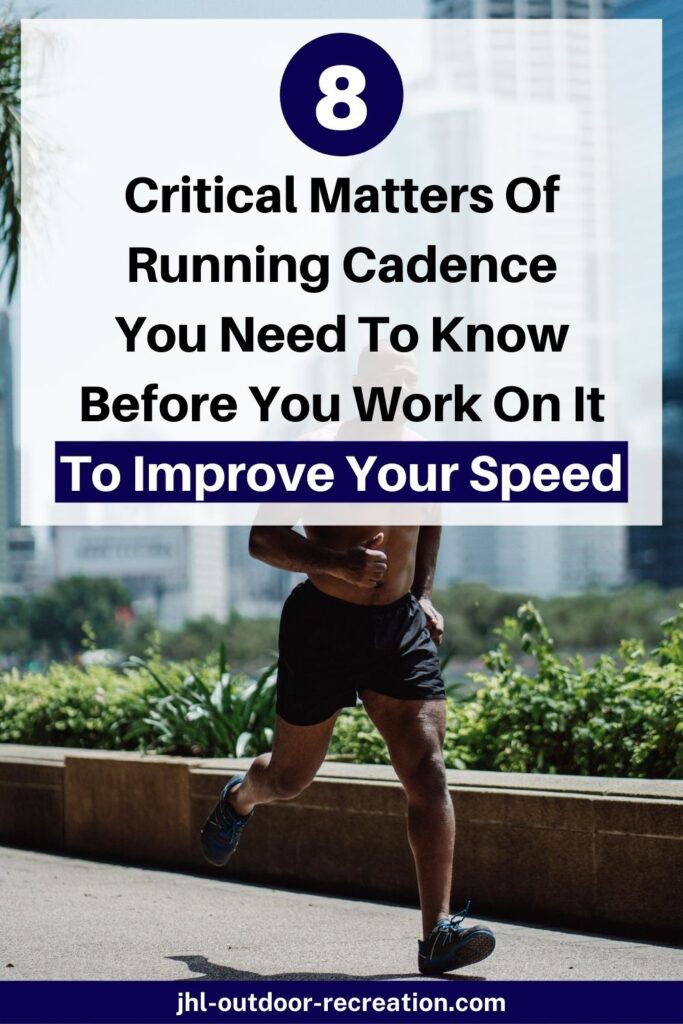In running world, you may notice many runners talk about running cadence. And they believe running cadence is important.
It seems like they are really obsessed with running cadence, aren’t they?
Have you experienced this before? When you have a chat with runners, they might say “oh, my running cadence is XXX”.
As a leisure runner, you absolutely have no idea what they are talking about. What does it mean? And you can’t fathom why running cadence is important to running.
You think running is simple. You just need to run, and that’s it. Then, you are happy with that.
The truth is: they are right. Running cadence is really important, although many runners overlook it. – So, you might need to change your mind.
That’s the purpose of this post. Here are the FAQs that are related to running cadence. I hope you have some ideas about running cadence and how to improve it.
1. What is running cadence?
Think about what we do in our daily lives. We walk, run, sprint, ride a bike, or even listen to music.
These things are in CYCLES and they keep repeating. Even music has its BEAT. – That’s why they have RHYTHMS.
The pace doesn’t matter, though. For example, if we walk slowly, the rhythm is slow. And vice versa……
Essentially, rhythms are CADENCE. Running cadence is just a distinct name for running rhythm.
We can express running cadence in 2 ways, ie.
- Steps rate (steps per minute)
- Strides rate (strides per minute)
2 steps make a complete cycle. And that cycle is 1 stride. So, if you hear someone saying 70 strides per minute, it also means 140 (70×2) steps per minutes.
Sometimes, some runners use both terms INTERCHANGABLY. For instance, someone might say “run 160 strides per minute”.
But, it doesn’t mean you need to run 320 steps per minute. It’s insane and impossible to do that! Even we can’t do that while sprinting!
What he might mean is to run 160 steps per minute. So, you don’t have to be surprised.
2. Why is running cadence important?
Runners care about cadence to RUN FAST. To help you understand this, let’s have a look at the equations below.

From the equation, speed and cadence have DIRECT relationship. Let’s say we maintain our step / stride length, increasing cadence leads to increasing speed.
However, we can also look the other way. Meaning, if you increase your speed, you might notice your cadence increases as well.
But, that is not the sole purpose of running cadence. We expect to run fast without getting out of breath and discomfort.
But, the reality is, we can’t sustain our pace and we get out of breath easily. What make it worse is we might sustain foot injuries.
Meaning, this is inefficient. So, we need to improve our RUNNING EFFICENCY.
That’s why running cadence is important! – To improve our running efficiency.
Hence, the real reasons include:
- Improve speed
- Use energy the most efficient way
- Reduce injuries
Just like the example above, these 3 areas are linked. Without having running efficiency, you notice you’ll struggle in all these 3 areas.
Sadly, not all runners are aware of these, despite the struggle. And the issues persist, which somewhat make running torturing.
So, understanding the reasons is the key. And we’ll look at the respective reasons in details below.
3. What is the optimal running cadence?

There’s a magic number that runners talk about. That is: 180 steps per minute (spm).
Many believe that this is the best cadence to run fast.
Thus, it might not be surprising that some runners are obsessed with this figure and try to hit the exact cadence.
But, this one-size-fits-all standard may not be true to all runners.
What about one of the best marathoners in the world, Eliud Kipchoge? His average cadence is 185 spm.
Besides, there are several reasons to explain why optimal running cadence differs.
3.1 Types of running
Let’s look at walking, jogging / running, and sprinting.
For walking, do you think it is necessary to hit 180 spm? – Obviously, no right?
Well, what about sprinting? 180 spm isn’t enough to sprint at all. In this article, the author showed that the different cadences of world-class sprinters:
- Usain Bolt: 221 spm
- Shelly-Ann Fraser-Pryce: 286 spm
- Justin Gatlin: 231 spm
So, what can we learn from this? Obviously, that magic cadence 180 spm only refers to distance running, but not to sprinting.
Plus, even for sprinting, the cadences of athletes vary greatly.
3.2 Height / sex
Usually, male runners have lower cadence than female runners. That’s due to the height of runners.
Since male runners are taller than female runners in general, this means that male runners’ legs are longer.
Meaning, male runners achieve bigger strides length, compared to female runners.
There is a study published by Journal Of Applied Physiology. This study was conducted on elite runners who ran 2016 International Association of Ultra-running 100-km World Championship.
At the end of the study, researchers found that:
- Average cadence of 182 +/- 12.1 spm
- Cadence ranged from 155.4 spm to 203.1 spm
- Average male cadence of 177.6 +/- 12.0 spm
- Average female cadence of 188.5 +/- 9.0 spm
- Speed influences cadence
- Height influences cadence
Below are what we can interpret.
Firstly, although the average cadence of 182 spm is close to 180 spm, the range of cadence is surprisingly big. – And these are the cadence of elite runners.
Secondly, the finding supports where height influences cadence, which is our point. Female runners, inherently, have greater cadence than male runners.
Thirdly, speed influences cadence. Greater speed leads to higher cadence. Hence, we can also look the other way round. Raise cadence to make us run faster.
This proves the formula above. And runners are right.
3.3 Experience / Fitness
The biggest difference between trained / elite runners and leisure runners is how they run.
Trained / elite runners try to run fast and the most efficient way. They crave for improving their performance.
In contrast, leisure runners run slowly or at average pace to try not to be out of breath.
What does this imply? Well, obviously the 180 spm are for trained / elite runners. If leisure runners try to run at this cadence, they can’t sustain it. Simple. Their body isn’t used to running at high cadence.
There was a study published by PLOS on the optimal stride frequency of inexperienced runners. The researchers found that the optimal stride frequency is around 83 strides / min (166 spm). Plus, all inexperienced runners ran below the optimal stride frequency.
There is a reduction of 14 spm (180 spm – 166 spm). In fact, it’s quite a lot. And it makes huge difference for the runners.
Trained / elite runners who run close to 180 spm might feel awkward running at 166 spm, too. And they might run much slower than their normal speed.
3.4 Slope
Again, that magic cadence refers to road running, ie. running on relatively flat surface.
If you are a trail runner, your running cadence may skew greatly.
While running uphill, you tend to shorten your stride length as you need to conserve energy. As a result, you increase your cadence.
The opposite is true, too. When running downhill, you tend to lengthen your stride length due to the gravity. And you might reduce your cadence……
4. Does high running cadence always make us run faster?
Again, try to understand the equation below.

As we can see, cadence is one of the factors to run fast. The stride / step length is another factor.
Do notice that both cadence and stride / step length have INVERSE relationship. Meaning, they might counteract with each other.
For example, when you increase your cadence, you might shorten your stride / step length. Vice versa.
Let’s recall your experience. You were once fatigue when running. What would you do?
Your stride / step length got smaller. At the same time, you increased your cadence, right?
In the end, your running speed might remain the same. Or, it could be reduced.
5. How does it save energy?
We always believe where high cadence tends to be more energy taxing. That’s because we need to engage our muscles more.
Well, this is just one side of the truth. What if I tell you your body doesn’t have to work harder if you run faster?
Amusing, isn’t it?
The truth is, the greater our cadence is, the less energy we consume while running. Then it reaches the OPTIMAL point.
But, once we surpass this point and we keep increasing our cadence, our energy consumption increases progressively.
So, this would be like a shape of a smiling face, if we were to plot a graph.
The study published by PLOS depicts this well. This study was on inexperienced runners. And it studied the relationship between stride frequency and heart rate (a measure of energy usage).
At the end of the study, researchers found that
- Heart rates of runners reduced as stride frequencies increased
- Lowest heart rate when the stride frequency was 83 strides per minute (optimal)
- Heart rates of runners increased progressively as stride frequencies increased beyond 83 strides per minute
- All runners’ personal stride frequencies were much lower than 83 strides per minute
This study explains the problems that leisure runners are facing. We have low cadence. And yet, we still feel our heart pumping like crazy. And we even gasp for air when running.
But, look at the trained / elite runners. They run fast with high cadence. And they don’t seem gasping for air at all.
Seem like it doesn’t make sense. But, now we know why.
This study also suggests that leisure runners can reduce energy usage by increasing running cadence.
6. How does it reduce injury risk?

Observe how elite runners run. If you only focus on the upper body movement, their bodies don’t undulate much. – Pretty much in a straight line.
And their foot strikes seem very light. This make them appear “gliding” on the road swiftly.
Conversely, leisure runners don’t run this way. Surprisingly, low-cadence running makes our run look “bumpy”. We undulate a lot, just like the shape of WAVE FREQUENCY.
And our foot strikes look really HEAVY, as if our steps are smashing onto the ground. Plus, we try to run faster by OVERSTRIDING our foot strikes.
Of course, these are detrimental, as these impose great stress on our ankle, calves, and knees. When this persists, we sustain foot injuries.
A study of SAGE Publications found that increasing step frequency / reducing step length lead to the following benefits:
- Reduced centre of mass vertical excursion
- Reduced ground contact force
- Decreased impact shock and attenuation
- Reduced energy absorbed at the hip, knee, and ankle.
This means increasing step frequency could potentially avoid or help ease running-related injuries.
7. Is it hard to change running cadence?
Changing running cadence sounds simple. Well, we just need to raise our running cadence.
Let’s say your current cadence is 150 spm and you wish to run at 180 spm, you need to run extra 30 spm. – It seems not that hard as you only raise 1 step per 2 seconds.
And you run at the magic cadence with this great margin. You expect this improves your speed right away.
But, the reality isn’t always like that.
Changing cadence could be HARD.
Think about this. Running at original cadence already forms a HABIT. Although you might be struggling to run, your body is already used to this.
Right now, you are trying to break this habit. But, your body RESISTS this change, although it is more efficient.
So, once you raise your cadence, even small bit, you’ll feel awkward / uncomfortable. You have the urge to fall back to your original cadence.
You have to grind through this discomfort for some time to let your body adjust to it.
After all, breaking old habit and forming new habit are always tough, aren’t they?
8. How to improve running cadence?
Let’s break down into some simple steps.
Step 1
Accept the fact that it’s hard to change cadence, but we can still make it. That’s why you’ve got to know the basic stuff above.
Step 2
Count your original running cadence. Then raise cadence with small margin. – Maybe increase by 1, 2, or 4 spm.
There are a few ways to count:
8.2.1 Count in mind
- You just need a watch to monitor the time
- Hard to concentrate. You need to mindfully count in your head while breathing, which can be quite distracting.
This would be the cheapest, yet toughest option. To ease your count, try to count STRIDES per minute, instead of STEPS per minute (spm). Then, simply TIMES 2 to get spm.
If you breathing pattern is 1 breath per stride, then this is good for you. Simply match your stride with your breath.
Another problem: it’s hard to run with “new” running cadence, as you have nothing to refer to. And this links to the following options.
8.2.2 Metronome app / smart watch
- Smart watches with metronome are expensive, unless you already have one
- You might need to download a metronome app, unless your phone already has the app
This could be the easiest way to count. You can set any cadence you like. And you just follow the “beep” sound, ie. cadence, of the device.
Besides, running with these can be stressful, as the “beep” sound keeps PUSHING you. And the sound is BORING.
So, you have the option below.
8.2.3 Music

- Smartphone / iPod
You might need to spend some time to find the music that has the beat close to the cadence you wanna run at.
You can use Spotify, for instance, for this purpose. There’s either free or premium version, which you can choose.
Although it works the same as metronome, running with music actually motivates us, rather than makes us bored and stressed.
In fact, our body can sync to the music beat, which makes it easier to adapt to new running cadence.
According to a study published by Springer Open, runners can run in sync with music tempo spontaneously.
So, if you don’t mind money or the time to search for right music tempo, this is your best option.
Step 3
Don’t over-train. Make this session 2 or 3 times per week. Or, you can practice this as your warming up session for your run.
Step 4
You can also include some drills, eg. high-knee drill, rope jumping.
Step 5
Don’t rush. Be persistent. Gradually increase the cadence. Your effort adds up. Trust your body.
Final thought
Cadence is important for running. Hence, many of us are into the magic cadence, 180 spm.
As discussed above, there are several factors that influence “optimal” running cadence. – Even the cadences among elite runners vary greatly.
But, 180 spm is still a great benchmark for runners, as this represents the average cadence of experienced runners. – It’s a benchmark for efficient running, too.
For leisure runners, although it might be hard to run at that level, we can still improve running efficiency by reworking our running cadence.
Let’s work and improve your cadence to make you run better.
Relevant posts
